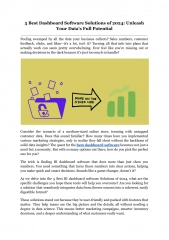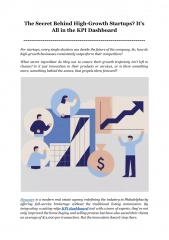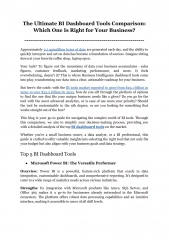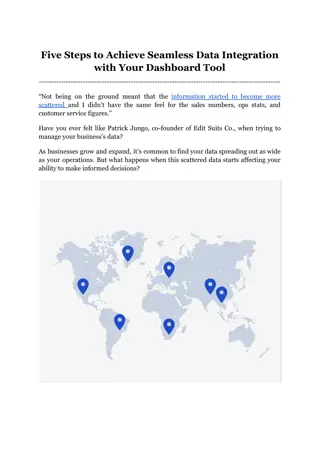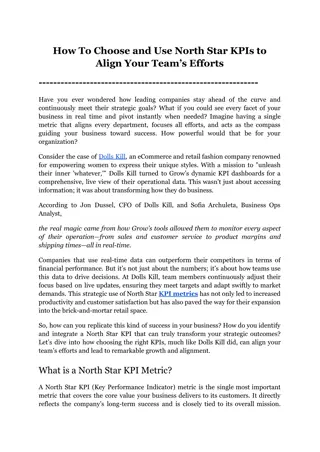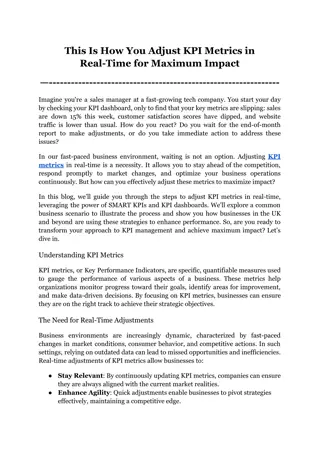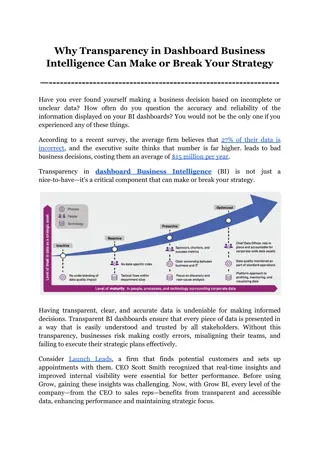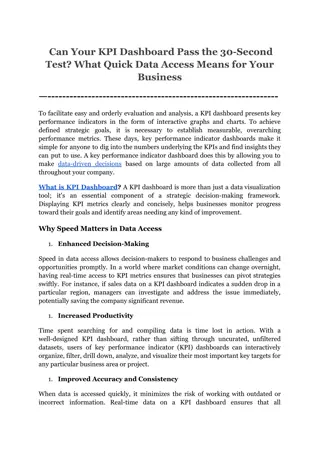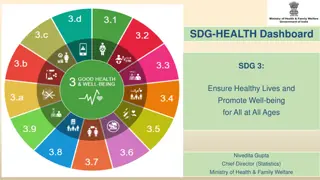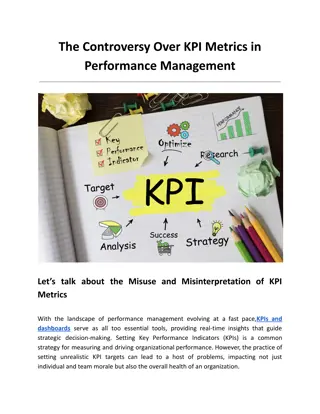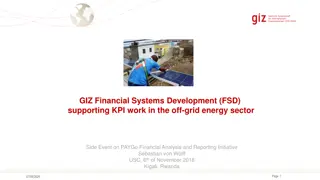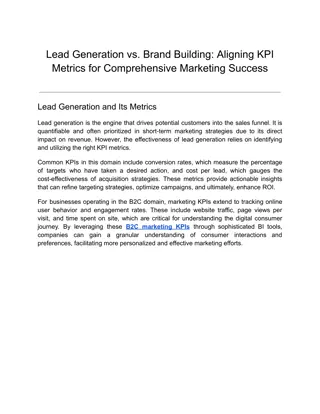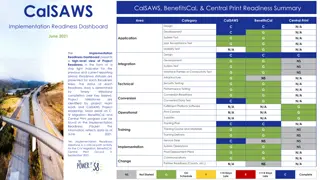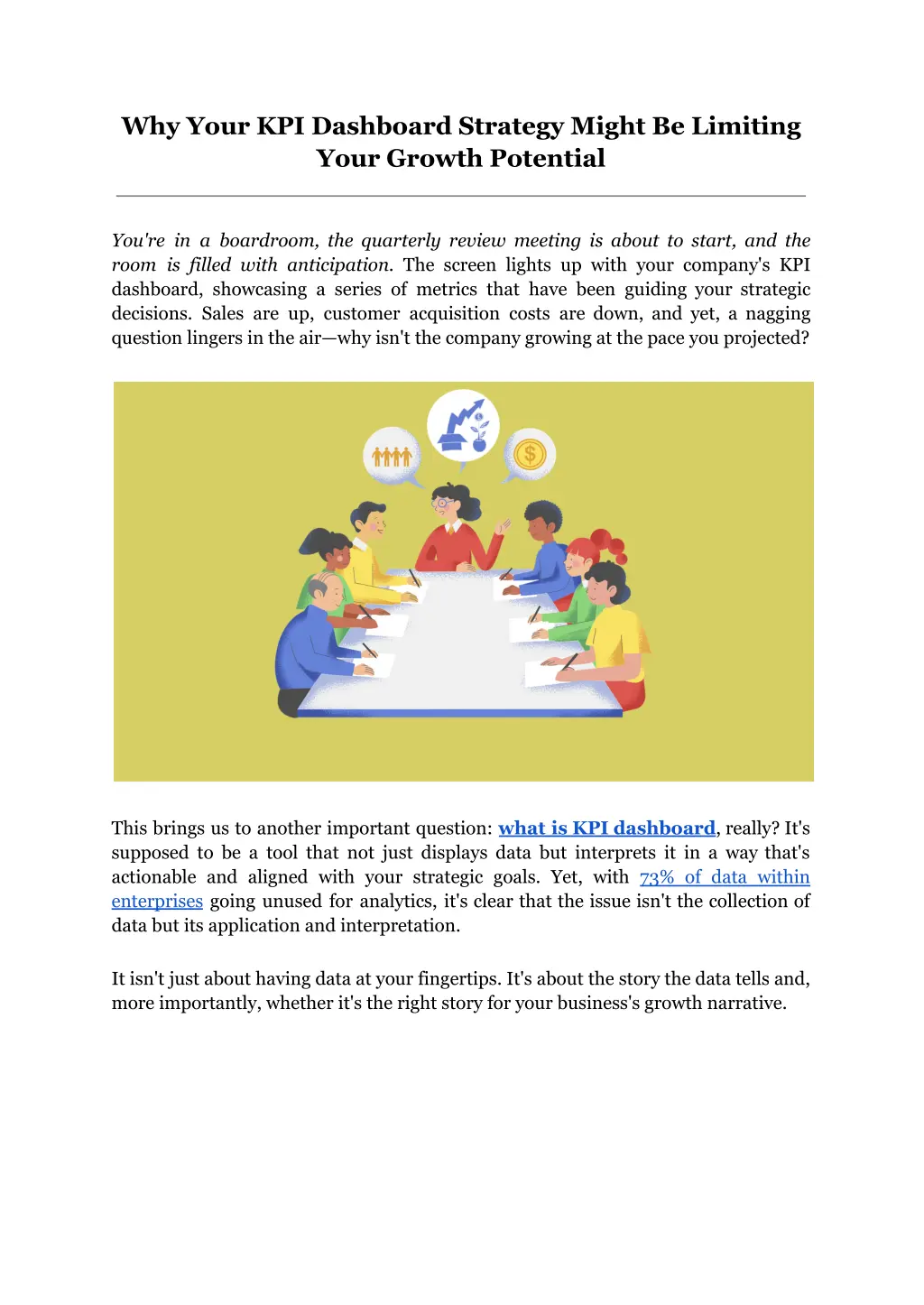
Why Your KPI Dashboard Strategy Might Be Limiting Your Growth Potential
Is your business leveraging its data to its fullest potential? Discover how common KPI dashboard strategies might be inadvertently capping your company's growth and learn strategies to unlock unparalleled expansion and efficiency. Explore the critical role KPI metrics play in shaping business strategies and uncover how misaligned approaches might be stifling your company's potential for growth and success.n
Download Presentation

Please find below an Image/Link to download the presentation.
The content on the website is provided AS IS for your information and personal use only. It may not be sold, licensed, or shared on other websites without obtaining consent from the author. If you encounter any issues during the download, it is possible that the publisher has removed the file from their server.
You are allowed to download the files provided on this website for personal or commercial use, subject to the condition that they are used lawfully. All files are the property of their respective owners.
The content on the website is provided AS IS for your information and personal use only. It may not be sold, licensed, or shared on other websites without obtaining consent from the author.
E N D
Presentation Transcript
Why Your KPI Dashboard Strategy Might Be Limiting Your Growth Potential You're in a boardroom, the quarterly review meeting is about to start, and the room is filled with anticipation. The screen lights up with your company's KPI dashboard, showcasing a series of metrics that have been guiding your strategic decisions. Sales are up, customer acquisition costs are down, and yet, a nagging question lingers in the air why isn't the company growing at the pace you projected? This brings us to another important question: what is KPI dashboard, really? It's supposed to be a tool that not just displays data but interprets it in a way that's actionable and aligned with your strategic goals. Yet, with 73% of data within enterprises going unused for analytics, it's clear that the issue isn't the collection of data but its application and interpretation. It isn't just about having data at your fingertips. It's about the story the data tells and, more importantly, whether it's the right story for your business's growth narrative.
This blog post delves into the nuances of KPI dashboard strategies, uncovering the subtle ways they might be capping your company's potential and how to recalibrate your course for maximum growth. Understanding KPI Dashboards A KPI dashboard is a confluence of analytics and business intelligence, designed to present an array of KPI metrics in an accessible, real-time visual format. These dashboards are pivotal in setting and tracking SMART KPI metrics Specific, Measurable, Achievable, Relevant, and Time-bound indicators that collectively drive strategic decision-making and operational efficiency. Why Your KPI Dashboard Strategy Might Be Limiting Your Growth Potential 1. Misalignment of KPIs with Business Objectives KPIs that do not align with the strategic goals of an organization can lead to misdirected efforts and resources. A company focused on enhancing customer satisfaction might mistakenly prioritize increasing website traffic as a KPI metric, overlooking metrics directly related to customer feedback and service quality. 2. Overemphasis on Vanity Metrics Vanity metrics look impressive on paper but offer little actionable value or insight into performance improvement. A retail business boasting about the number of new customer sign-ups without considering customer retention rates or lifetime value may find itself investing in strategies that don't contribute to long-term growth. 3. Failure to Use SMART KPIs KPIs that aren t Specific, Measurable, Achievable, Relevant, and Time-bound (SMART) can lead to ambiguous targets and inefficiency. "Increase sales" is a vague objective. A SMART KPI would be "Increase online sales by 20% within the next fiscal quarter through targeted social media advertising campaigns." Learn How To Set-Up A SMART KPI System in this blog. 4. Lack of Real-Time Data Integration
Without real-time data, KPI dashboards can provide outdated information, leading to delayed or incorrect decisions. A manufacturing company relying on weekly production data may fail to quickly address supply chain disruptions, whereas real-time monitoring could allow for immediate adjustments. 5. Insufficient Data Context Presenting KPI metrics without adequate context can lead to misinterpretation and misguided strategies. For example, If a dashboard shows a sudden drop in website traffic without context, it may seem alarming. However, if the data is contextualized with information about recent website maintenance or updates, the decrease could be seen as expected and temporary. 6. Ignoring Dashboard Usability and Design Complex or non-intuitive dashboard designs can hinder the accessibility of insights, limiting their effectiveness across the organization. A dashboard that crams too much information into a small space or uses complex visualizations may confuse users, rather than enable quick, informed decisions. 7. Neglecting to Update KPIs Over Time Failing to regularly review and update KPIs can result in a dashboard that no longer reflects current business objectives or market conditions. A company that set KPI metrics focused on in-store sales before the COVID-19 pandemic may need to shift its focus towards online sales metrics to stay relevant in a changed retail environment. 8. Overreliance on Quantitative Metrics Alone Focusing solely on quantitative data can overlook qualitative insights that might be crucial for strategic decisions. A service provider might have excellent ratings for speed of service (quantitative) but poor feedback on customer service quality (qualitative), indicating areas for improvement not visible in numbers alone.
How These Pitfalls Limit Growth Potential The ramifications of these pitfalls are far-reaching. Stagnation in strategic decision-making arises when teams are guided by misaligned or superficial KPIs, effectively hampering progress. Similarly, a failure to leverage real-time data or actionable insights can see businesses missing out on pivotal opportunities for innovation and adaptation. Furthermore, incorrect data interpretation due to insufficient context or poor dashboard UX can lead to resource misallocation, directly impacting the return on investment and stifling growth. Optimizing Your KPI Dashboard Strategy for Growth To counter these limitations, businesses must endeavor to align their KPIs with overarching business objectives meticulously. This alignment ensures that every tracked metric is a stepping stone toward achieving strategic goals. Emphasizing actionable metrics over vanity metrics further guarantees that the focus remains on insights that drive decisions and improvements. Integrating real-time data sources into your KPI dashboard facilitates a dynamic approach to strategy, allowing businesses to remain agile and responsive to market changes. Providing comprehensive data context enriches the narrative behind the numbers, ensuring stakeholders have a holistic understanding of what the metrics signify. Lastly, improving the usability and accessibility of the dashboard itself democratizes data, enabling informed decision-making at all levels of the organization. A user-friendly design ensures that the insights gleaned from the KPI dashboard are not confined to data analysts but are accessible to all stakeholders, fostering a data-driven culture throughout the organization. Conclusion A finely tuned KPI dashboard strategy transcends mere data aggregation; it embodies a vital tool for fostering sustainable growth and carving out a competitive edge. At Grow, we understand the intricacies and potential stumbling blocks inherent in deploying KPI dashboards effectively. By sidestepping these common pitfalls, your business is poised to unleash its inherent potential, steering towards a future where decisions are not just data-informed but strategically intelligent and aligned with SMART KPI principles. Grow specializes in crafting bespoke KPI dashboard solutions that cater to the unique needs of your business. Our platform is designed to empower your team, providing clear, actionable insights that drive strategic decisions and operational
efficiency. Whether you're grappling with aligning your KPIs with overarching business goals, seeking real-time data integration, or aiming for a dashboard that offers both depth and clarity, Grow's suite of tools and services is your gateway to optimization. Discover why we're highly rated on Capterra. Visit "Capterra Grow.com" for reviews and more information on how Grow can help you harness the true power of your data. Unlock your business's full potential with Grow. Start your 14-day free trial today.

